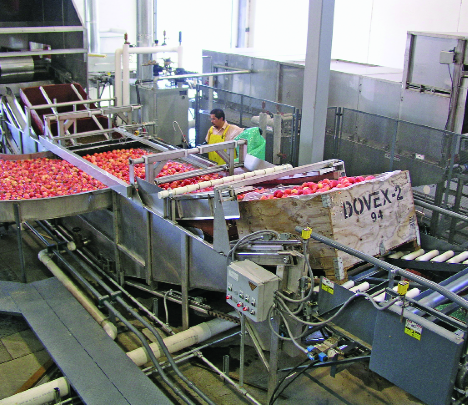
Dovex unveils
revamped packing facility
A bin sanitizer, to clean bins after the fruit has been emptied out, is one of the features of Dovex Fruit Company’s new packing line. This is designed to ensure that pests and disease organisms aren’t cycled back to orchards.
The company’s packing facility at Olds Station in Wenatchee, Washington, underwent a major revamp this summer to improve efficiency and enhance fruit quality. The changes were highlighted during an open house.
The new dry packing line can handle between 500 and 600 bins of fruit in an eight-hour shift, resulting in a 50 percent savings in labor, according to Jay Fulbright, general manager. The previous packing line is now dedicated to organic fruit.
The shipping and storage area has been expanded and reorganized with the goal to able to load three trucks simultaneously with a turnaround time of an hour or less.
A new 40,000-bin CA facility has rooms as small as 675 bins. This allows relatively small quantities of fruit to be removed from storage without needing to open big rooms.
Dovex packs about 6 million boxes of conventional and organic apples, pears, and cherries annually.
(Photo by Geraldine Warner)
A third of the 3,000-plus acres of tree fruit owned or operated by Dovex Fruit Company of Wenatchee, Washington, is organic or transitioning to organic. “The trends are still positive,” said Noel Adkins, general manager for the company’s orchards.
With mainstream retailers now handling organics, there’s a gap in production of some varieties, he noted. “We’re very high on organic.” Adkins said organic producers need to keep up with market trends. “We’ll have to adjust as we go along to find out what varieties they do want. Just because you grow them organically doesn’t mean you have to market them organically.
What you have to do is find what the best dollar to the acre is, whether it’s organic or conventional.” Dovex’s orchard managers use mating disruption for both codling moth and leafroller control. Though codling moth is a challenge, it can be controlled. But that’s not necessarily the case with grape mealybug in organic pear orchards.
“We haven’t found any organic products that you can kill or suppress them with and not mark the pears,” Adkins said. The company had one of its best pear blocks in the Wenatchee Valley in the organic program, and tried various tactics against grape mealybug, such as cutting off the tops of the leaders to remove mealybug habitat, and applying lime sulfur sprays in the fall. The block was surrounded by conventional orchards.
“We did everything,” Adkins said, “but it was not successful. There are some blocks, even though you have the desire, that are just not going to work with the knowledge we have today.” In organic production, it’s important to improve the organic matter content in the soil, he said. Some orchards had as little as 0.2 percent organic matter after 30 years of herbicide treatments in the tree rows.
Now, mowed grass is put in the rows and mixed in with the soil, and nitrogen is added in the form of feathermeal. Fish-based foliar feeds are also applied. Compost tea is applied as a foliar spray for disease suppression, though Adkins said it’s a challenge to get a consistent quality tea in any volume. “The concept of it
Mint compost
Dovex’s organic orchards use a mint compost. David Granatstein, with Washington State University, said a major mint farmer in Washington’s Columbia Basin is making compost out of the waste that is produced when mint oil is distilled, as a way to dispose of it. A number of orchardists are using it as a soil amendment and mulch. It has lower salt and nitrogen content than poultry manure, and the waste is already heat-treated during the distillation process.
Because it’s locally produced, hauling should not be too expensive. “It’s a nice product,” Granatstein said. “It breaks down quickly and has a nice carbon-to-nitrogen ratio.” However, when Granatstein tested it as a mulch for weed control, weed seeds grew in it as if it were potting mix. Adkins said weeds in Dovex’s organic orchards and even in some of its conventional blocks are controlled mechanically.
Lime sulfur is applied during bloom for thinning, and this also is being used in conventional orchards, as the sulfur helps control mildew. However, Fuji is difficult to thin with lime sulfur, and in some cases, lime sulfur has caused phytotoxicity. For the past five years or so, Dovex’s orchard managers have been mixing micronized sulfur with a lesser rate of lime sulfur, and found it works well, he said.
Codling moth
Dr. Jay Brunner, director of Washington State University’s Tree Fruit Research and Extension Center in Wenatchee, described how a problem with codling moth in one of Dovex’s organic orchards in the Columbia Basin was brought under control. In 2002, as many as 67 codling moths were trapped weekly in August.
Workers hand culled 158 bins of damaged fruit from the 270-acre block, which took 989 worker hours. Excessive use of oil was affecting the trees and fruit quality. Costs were high, and there was still 5 percent fruit damage at harvest. Dovex was on the verge of reverting to a conventional program.
New approach
In 2003, Brunner recommended a new approach to controlling codling moth, using mating disruption, Entrust (the organic formulation of spinosad), codling moth granulovirus, and minimal oil treatments. The cost of controlling codling moth increased from $407 per acre to $487 per acre, but the amount of lost fruit dropped from 368 bins to 38 bins.
There was no hand culling, and damage at harvest was less than 1 percent. In 2004, mating disruption was supplemented with oil (1.4 applications per acre, on average), limited use of the granulovirus (1.3 applications per acre, on average), and spot treatments with Entrust. The cost dropped to $190 per acre.
Only 80 moths were trapped the whole season, and fruit injury was negligible. At harvest, damage was less than half a percent. “We’re hoping that’s a sustainable program, where you have the pest under control,” Brunner said.



Leave A Comment